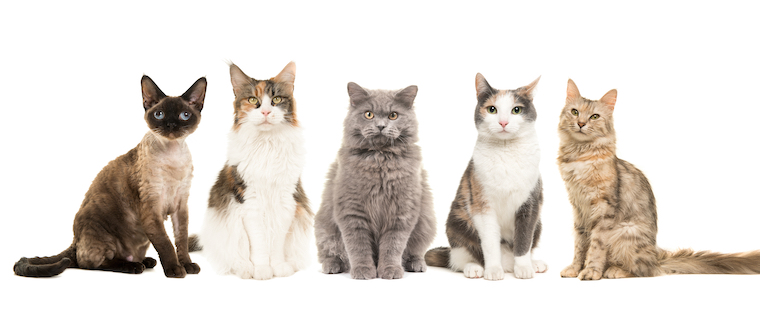Dog owners seem to always talk about breeds. They may always describe their dog by breed (“my Golden Retriever Sampson”) or talk about breeders like beloved stores (“the best Jack Russell breeder in South Carolina”). Breed names also offer a terminology for even non-pet-owners to help describe a dog’s appearance: “he has a Bulldog-like face” or “she has legs like a Greyhound.” But does that work for cat owners as well? Are there cat breed traits like dogs?
The answer is yes – but for many of us, cat breeds just aren’t as well-known as dog breeds. In fact, there are 40-70 different breeds of cats – though that number depends on who you ask. The CFA (Cat Fanciers Association) recognizes 42 pedigree breeds of cats, while TICA, the International Cat Association, recognizes 71 cat breeds. As with dog organizations like the American Kennel Club, these cat associations strictly define a breed’s characteristics and hold competitions for cats who display the pinnacle of these breed traits.
Breeds can have long hair, short hair or no hair. Some have giant, triangular ears, while others’ ears are rounded, floppy, or barely visible. Some have leopard-like spots, while others are vividly striped or solid white. Their likes and dislikes, temperaments and personalities can widely vary as well.
Some of the names of cat breeds include:
|
American Curl American Shorthair Berman Javanese Persian Russian Blue Siamese |
Abyssinian Bengal British Shorthair Norwegian Forest Cat Ragdoll Scottish Fold Sphynx |
Petfinder lists many of the breeds and lets you filter a search by temperament, color and more to find your ideal breed (search cat breeds and their personalities here).
So, what breed is my cat?
Odds are, if you don’t know your cat’s breed, you likely have a Domestic Shorthair (or Longhair). It is estimated that 95% of cats in the U.S. are Domestic Longhair or Domestic Shorthair cats (not be confused with the American Shorthair, which is a distinct breed). This most common cat “breed” in the U.S. is not a recognized pedigree at all. Instead, it’s a term to lump together the varied colors, personalities and sizes of the almond-eyed, pointy-eared cat we are most familiar with.
So much like dog owners, cat owners can choose to fuss about their pet’s breed lineage and distinct characteristics. Or also like dog owners, they can embrace the “mutt” cats that make up most of America’s population. Either way, we can agree that cats are beautiful, whatever their lineage.













